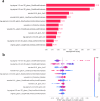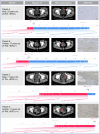A radiomics-based interpretable machine learning model to predict the HER2 status in bladder cancer: a multicenter study
- PMID: 39466475
- PMCID: PMC11519251
- DOI: 10.1186/s13244-024-01840-3
A radiomics-based interpretable machine learning model to predict the HER2 status in bladder cancer: a multicenter study
Abstract
Objective: To develop a computed tomography (CT) radiomics-based interpretable machine learning (ML) model to preoperatively predict human epidermal growth factor receptor 2 (HER2) status in bladder cancer (BCa) with multicenter validation.
Methods: In this retrospective study, 207 patients with pathologically confirmed BCa were enrolled and divided into the training set (n = 154) and test set (n = 53). Least absolute shrinkage and selection operator (LASSO) regression was used to identify the most discriminative features in the training set. Five radiomics-based ML models, namely logistic regression (LR), support vector machine (SVM), k-nearest neighbors (KNN), eXtreme Gradient Boosting (XGBoost) and random forest (RF), were developed. The predictive performance of established ML models was evaluated by the area under the receiver operating characteristic curve (AUC). The Shapley additive explanation (SHAP) was used to analyze the interpretability of ML models.
Results: A total of 1218 radiomics features were extracted from the nephrographic phase CT images, and 11 features were filtered for constructing ML models. In the test set, the AUCs of LR, SVM, KNN, XGBoost, and RF were 0.803, 0.709, 0.679, 0.794, and 0.815, with corresponding accuracies of 71.7%, 69.8%, 60.4%, 75.5%, and 75.5%, respectively. RF was identified as the optimal classifier. SHAP analysis showed that texture features (gray level size zone matrix and gray level co-occurrence matrix) were significant predictors of HER2 status.
Conclusions: The radiomics-based interpretable ML model provides a noninvasive tool to predict the HER2 status of BCa with satisfactory discriminatory performance.
Critical relevance statement: An interpretable radiomics-based machine learning model can preoperatively predict HER2 status in bladder cancer, potentially aiding in the clinical decision-making process.
Key points: The CT radiomics model could identify HER2 status in bladder cancer. The random forest model showed a more robust and accurate performance. The model demonstrated favorable interpretability through SHAP method.
Keywords: Bladder cancer; Computed tomography; HER2; Machine learning; Radiomics.
© 2024. The Author(s).
Conflict of interest statement
The authors declare that they have no competing interests.
Figures





Similar articles
-
Interpretable CT Radiomics-based Machine Learning Model for Preoperative Prediction of Ki-67 Expression in Clear Cell Renal Cell Carcinoma.Acad Radiol. 2025 May;32(5):2739-2750. doi: 10.1016/j.acra.2024.11.072. Epub 2025 Jan 9. Acad Radiol. 2025. PMID: 39788813
-
Machine learning models combining computed tomography semantic features and selected clinical variables for accurate prediction of the pathological grade of bladder cancer.Front Oncol. 2023 May 8;13:1166245. doi: 10.3389/fonc.2023.1166245. eCollection 2023. Front Oncol. 2023. PMID: 37223680 Free PMC article.
-
A radiomics-based interpretable model to predict the pathological grade of pancreatic neuroendocrine tumors.Eur Radiol. 2024 Mar;34(3):1994-2005. doi: 10.1007/s00330-023-10186-1. Epub 2023 Sep 2. Eur Radiol. 2024. PMID: 37658884 Free PMC article.
-
Development and Validation of an Ultrasound-Based Radiomics Nomogram for Identifying HER2 Status in Patients with Breast Carcinoma.Diagnostics (Basel). 2022 Dec 12;12(12):3130. doi: 10.3390/diagnostics12123130. Diagnostics (Basel). 2022. PMID: 36553137 Free PMC article.
-
Machine learning for predicting neoadjuvant chemotherapy effectiveness using ultrasound radiomics features and routine clinical data of patients with breast cancer.Front Oncol. 2025 Jan 14;14:1485681. doi: 10.3389/fonc.2024.1485681. eCollection 2024. Front Oncol. 2025. PMID: 39927116 Free PMC article.
Cited by
-
An online explainable ensemble machine learning model for predicting epidermal growth factor receptor mutation status in lung adenocarcinoma.Transl Lung Cancer Res. 2025 Jul 31;14(7):2670-2687. doi: 10.21037/tlcr-2025-237. Epub 2025 Jul 28. Transl Lung Cancer Res. 2025. PMID: 40799429 Free PMC article.
-
Noninvasive identification of HER2 status by integrating multiparametric MRI-based radiomics model with the vesical imaging-reporting and data system (VI-RADS) score in bladder urothelial carcinoma.Abdom Radiol (NY). 2025 Jul;50(7):3126-3136. doi: 10.1007/s00261-024-04767-x. Epub 2025 Jan 9. Abdom Radiol (NY). 2025. PMID: 39786584
-
Ultrasound-Based Deep Learning Radiomics Models for Predicting Primary and Secondary Salivary Gland Malignancies: A Multicenter Retrospective Study.Bioengineering (Basel). 2025 Apr 5;12(4):391. doi: 10.3390/bioengineering12040391. Bioengineering (Basel). 2025. PMID: 40281751 Free PMC article.
-
Different radiomics models in predicting the malignant potential of small intestinal stromal tumors.Eur J Radiol Open. 2024 Nov 25;13:100615. doi: 10.1016/j.ejro.2024.100615. eCollection 2024 Dec. Eur J Radiol Open. 2024. PMID: 39659979 Free PMC article.
References
-
- van Hoogstraten LMC, Vrieling A, van der Heijden AG, Kogevinas M, Richters A, Kiemeney LA (2023) Global trends in the epidemiology of bladder cancer: challenges for public health and clinical practice. Nat Rev Clin Oncol 20:287–304 - PubMed
-
- Lobo N, Afferi L, Moschini M et al (2022) Epidemiology, screening, and prevention of bladder cancer. Eur Urol Oncol 5:628–639 - PubMed
-
- Lenis AT, Lec PM, Chamie K, Mshs MD (2020) Bladder cancer: a review. JAMA 324:1980–1991 - PubMed
-
- Patel VG, Oh WK, Galsky MD (2020) Treatment of muscle-invasive and advanced bladder cancer in 2020. CA Cancer J Clin 70:404–423 - PubMed
-
- Lopez-Beltran A, Cookson MS, Guercio BJ, Cheng L (2024) Advances in diagnosis and treatment of bladder cancer. BMJ 384:e076743 - PubMed
Grants and funding
LinkOut - more resources
Full Text Sources
Research Materials
Miscellaneous

